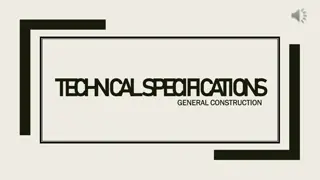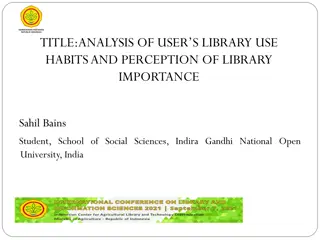Experimental Considerations for Library Construction: Input Material & Quality Control
This content provides insights into experimental considerations for library construction, focusing on input material quantification, quality control methods, and considerations for DNA, RNA, and ChIP-Seq library preparation. It covers topics such as methods for DNA and RNA quantification, optimal insert size determination, multiplexing considerations, and more. The importance of quality checking input materials before library construction is emphasized to ensure successful sequencing outcomes.
Download Presentation

Please find below an Image/Link to download the presentation.
The content on the website is provided AS IS for your information and personal use only. It may not be sold, licensed, or shared on other websites without obtaining consent from the author.If you encounter any issues during the download, it is possible that the publisher has removed the file from their server.
You are allowed to download the files provided on this website for personal or commercial use, subject to the condition that they are used lawfully. All files are the property of their respective owners.
The content on the website is provided AS IS for your information and personal use only. It may not be sold, licensed, or shared on other websites without obtaining consent from the author.
E N D
Presentation Transcript
Library QA & QC Day 1, Video 3 Experimental considerations for library construction Considerations for input material Quantification by Qubit Quality control by Bioanalyzer Quantification and quality control by qPCR
Experimental considerations Single read vs. Paired end reads Read length Sequencing Depth/Coverage Replicates Coverage = bp Sequence bp Genome These will direct you to a specific platform MiSeq: 15-25M clusters per run, 50-300bp read length HiSeq v3: 150-200M clusters per lane, 50-100bp read length
Input DNA (genomic DNA) Which method or kit to use? How much: >1 ug or <10 ng What is the quality? How will you fragment? What is your optimal insert size, does it matter? Are you concerned about amplification bias (high/low GC, etc) Other considerations: Multiplexing: how many do you need to get on one lane Is there a reference genome available?
Input - RNA Which method or kit to use? How much: >1 ug or <10 ng or single cell What is the quality? Total RNA vs. poly-A RNA vs. ribosomal removal Strand specific or not? Unlike with DNA sequencing/resequencing these questions will often depend on what question you are asking Differential expression Isoform analysis De novo transcriptome assembly
ChIP-Seq Library kits available that deal with low input, but most of the steps are performed outside of a kit Every step likely requires some optimization Antibody choice require good signal to noise No antibody controls Crosslinking reagent and time Fragmentation
Always check the quality of your input material! gDNA: Intact, high MW DNA on agarose gel Quantify input by Qubit (fluorescent DNA and RNA assays) Check size after fragmentation on Bioanalzyer Total RNA: Run on Bioanalyzer RNA nano or RNA pico Quantify RNA by Qubit (RNA assay) Check ribosomal removal before fragmentation ChIP: check no-antibody controls Check size after fragmentation on Bioanalyzer
Quantification of DNA/RNA Use a fluorescent method Qubit or picoGreen Dye binds specifically to dsDNA or RNA In many cases measure both DNA and RNA by Qubit Nanodrop quantification can be off by an order of magnitude! Requires ~2uL sample
Bioanalyzer whats the deal? Agarose gel meets microfluidics - Measures fluorescence (DNA or RNA) versus time Great for size estimates at low concentrations Great for determining quality of total RNA Not so great for quantification
Determination of input RNA quality RNA Nano (5-500 ng/uL) or RNA Pico (50-5000 pg/uL) RNA Integrity Number (RIN) indicator of quality Monitor rRNA depletion
During library construction High Sensitivity DNA chip (5-500 pg/uL) Monitor fragmentation (RNA or DNA) Check for problems: Over-amplification adapter-dimer, primer- dimer, excess primers Determine size range of final library Adapter-dimer Excess primers Over-amplification
Final QC - qPCR Primers for P5 and P7 ends of the adapters only detect molecules with both adapters bound Requires significant dilution, can lead to large errors Final concentration calculation depends on the size of your library Adapter-dimers WILL be amplified (can check on gel after qPCR)
Comparison between methods Rarely see the same concentration by Qubit, Bioanalyzer and qPCR Ratios between qPCR:Qubit (molar) typically between 0.8-2.0 for well-performing libraries Higher ratios may indicate over-amplification or significant adapter-dimer, check the Bioanalyzer Low ratios may indicate a problem with adapter ligation It is better to make a new library than to sequence a terrible library!!
QC and sequencing facilities Every facility has their own proven method trust the experts and have them do quantification even if you have already done it! Every instrument is slightly different Relationship between loading concentration and cluster density is not a simple one! Everything about your library is important for your sequencing facility to know Library construction method, quality of input, size distribution, strain/species, potential low sequence complexity, barcoding method, previous performance (if known), etc.























